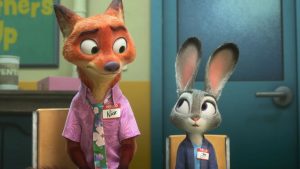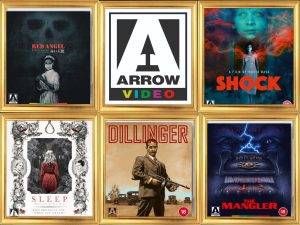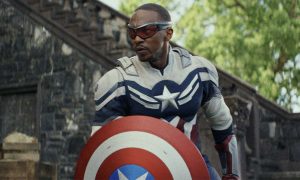
An Introduction
I love Star Trek.
Ever since seeing The Original Series as a kid, Star Trek has captured my imagination. Swashbuckling heroes. Tales of morality. Adventures among the stars. Cheap special effects? Who cares? Good storytelling will buy you a lot of insulation.

Star Trek: The Next Generation
When the production of Star Trek: The Next Generation was announced in the mid-1980s, I was skeptical. How do you recapture lightning in a bottle? Also, typically, my loyalty to Captain Kirk and his crew demanded that nobody could, or should, ever replace them.
Episodes in the early seasons of Star Trek: The Next Generation were hit and miss. But nobody was doing episodic science fiction back in the 1980s. That meant that TNG was exploring new territory in more ways than one. There was also enough good to buy goodwill. Special mention to Patrick Stewart, who was magnificent from the first episode and gave the show the credibility it needed while it was finding its way.

Star Trek: Deep Space Nine
Star Trek: Deep Space Nine was something different. It was Star Trek without the trekking. Again, episodes in its early seasons were uneven. But they got so much right. Colm Meany gave us some continuity from TNG (Meaney always comes across as so likable). In addition, Armin Shimerman rehabilitated the Ferengi’s image through his performance as Quark.
However, the biggest props go to Nana Visitor as Kira Nerys, the station’s first officer, and Bajoran liaison, and Avery Brooks as Benjamin Sisko. Sisko was like a hybrid of Kirk and Picard. Brooks gave his portrayal the gravitas and subtlety it needed.

Star Trek: Voyager
The concept behind Star Trek: Voyager was good. Fling a Starfleet ship across the galaxy and base the premise on them getting back home. But the series is a missed opportunity. The idea of being lost should’ve involved greater compromise on the crew’s pristine Starfleet ideals. It also should’ve taxed Star Trek: Voyager and her resources more. Yet, every episode reset the status quo. Too often, it felt like a pleasant cruise, with Starfleet just around the corner.
Credit to Kate Mulgrew for playing the first female captain to lead a Star Trek show, but even she has admitted the writing of Captain Janeway was inconsistent. The standouts were Jeri Ryan as Seven of Nine, Robert Picardo as the doctor, Roxann Dawson as half-Klingon engineer B’Elanna Torres, and a criminally underused Robert Beltran as Chakotay. Still, Star Trek: Voyager is largely inoffensive, with some great episodes.

Star Trek: Enterprise
Star Trek: Enterprise went backward instead of forwards in the timeline and looked at the foundation of the Federation. In itself, that’s a good idea. However, they never really seemed sure about how they were going to do that, while the series’ key arc, the Temporal Cold War, remained this amorphous thing seeking definition.
There were also annoying episodes where the crew interacted with characters (e.g. the Ferengi, the Borg) that their on-screen successors would only meet for the first time decades later. Surely, in all of space, there’s enough potential to create something new, rather than drawing on established properties that have no right in this timeframe.

Through the runs of Star Trek: Voyager and Star Trek: Enterprise, it felt like the key off-screen figures behind Star Trek had become complacent and too comfortable in their universe, thus losing the verve and urgency that made Star Trek: The Next Generation and Star Trek: Deep Space Nine so successful.
It wasn’t until the middle of season three that Star Trek: Enterprise would genuinely begin to develop its own identity but, sadly, it would last only one more season before it was canceled – the first of the modern incarnations of Trek not to go seven seasons.
JJ Trek
JJ Abrams rebooted Star Trek in 2009 with Star Trek, recasting The Original Series’ characters and diverging the timeline. It’s terrible and the lobotomization of Star Trek into a bland Star Wars imitation – more action-oriented with improbable plotting, as well as contrivance after contrivance pushing the story along to where it needs to go.

The sequel, Star Trek Into Darkness (2013), is one of the worst things I’ve seen. Abrams continues to murder The Original Series characters – in this case Khan (originally played by Ricardo Montalban, but here by Benedict Cumberbatch).
None of this story (involving using a twentieth-century criminal to design twenty-fourth-century weapons) makes sense. These movies simply draw on The Original Series marquee to glamorize turds rather than build anything genuinely new of their own.

Star Trek Beyond (2016) isn’t as offensive. At best, it’s bland. However, given it was effectively the end of the rebooted cinematic franchise, it tells you that while fans hungered for Trek and might’ve bought into the 2009 incarnation out of desperation (and novelty), now they had seen just how disingenuous it was.
This has nothing to do with the actors or their performances – they sell it as best as they can (with Karl Urban and Zoe Saldana being standouts). Also, aesthetically, it’s gorgeous, transforming 1960s sets, costumes, and special effects into something dazzlingly and suitably futuristic. But all this can only carry so much drivel.

The New Television Universe
We returned to television with Star Trek: Discovery. Due to rights issues, this new series had to divorce itself to some extent (allegedly twenty-five percent) from cinematic assets, such as the way the Klingons have been portrayed (with ridged heads) since Star Trek: The Motion Picture (1979) was released.
Now, I’m unsure if that’s the real reason the creators and writers shat on Star Trek by rewriting canon (giving Spock a sister he never previously mentioned in eighty-one episodes and six movies), rewriting technology (and Trek sciences), and dumbing down the universe so they could play it more for action.

It’s horrifically objectionable, with shallow supporting characters, while squandering potentially good characters, such as Joann Owosekun (Oyin Oladejo), and Keyla Detmer (Emily Coutts) to ensure that Michael Burnham (Sonequa Martin-Green) is the driver behind every solution. Compare that to conferences in the previous series where each character would make suggestions filtered through their modality.
Star Trek: Picard followed and proved no better. Again, Patrick Stewart’s presence lent it some credibility, but sadly – as occurs nowadays so often when we revisit franchise characters – he’d grown old and embittered and disassociated from everything we knew about him. The first two seasons of Star Trek: Picard is every bit as dumbly plotted as Star Trek: Discovery.

Star Trek: Strange New Worlds was the next series. Christopher Pike (Anson Mount), Captain Kirk’s predecessor, appeared in Discovery’s second season and became an immediate fan favorite (potentially because he was written like a genuine Star Trek character). It wasn’t long before Pike earned his own series.
Star Trek: Strange New Worlds isn’t as stupid as Star Trek: Discovery or Star Trek: Picard, and there are several very solid episodes that play out like Real Trek: moral dilemma, conflict, and there’s usually a denouement where we learn something through the characters. Mount is brilliant as Pike – every bit the Starfleet captain you’d expect, and a worthy successor to Kirk, Picard, Sisko, Janeway, and Archer.

The other characters are very hit-and-miss, with some strange origin choices, e.g. La’an Noonien-Singh (Christina Chong) being descended from Khan – surely that’s something Spock might’ve mentioned when Khan eventually appears in The Original Series. Still, there’s enough promise in Star Trek: Strange New Worlds, enough Trek, that it’ll be interesting to see what they do next.
The Orville
Some will defend the new series of Trek, and condemn my criticisms as somebody too attached to the past, unappreciative of the reality that television (and storytelling) evolve, and that Star Trek has to evolve with it. That’s why we get darker series, darker storylines, and (seemingly) grittier characters. Bullshit.
Created by Seth McFarlane (a Star Trek fan), The Orville is a clone of Star Trek. Indeed, people who were involved in Star Trek: The Next Generation are also involved in The Orville. The show mimics Star Trek: The Next Generation, emulating its look and feel to such a large extent you have to wonder how there aren’t plagiarism issues.

The pilot episode of The Orville is one of the stupidest, unfunniest, repulsive things I’ve ever seen. It feels as if Seth McFarlane might’ve crammed in as many dumb jokes as he could because that’s what was expected of him, and potentially this is what he might’ve promised to get the series off the ground.
But as The Orville goes on, it becomes great science fiction. The second half of the first season and the second season are excellent. The third season lacks a little of the purpose of the first two but still has strong episodes. When I advise people to watch it, I describe that it’s what The Next Generation would’ve been had they got a season eight. It’s also Trekkier than the Trek currently going around.

The Orville proves you can still do thoughtful, challenging science fiction, and a lot of the defenses of New Trek (and particularly Star Trek: Discovery) are smokescreens. Moreover, they’re not going to gain appreciation with time (as some suggest), and drawing parallels to the way predecessors were originally received (such as claims nobody initially liked Star Trek: Deep Space Nine because it was dark, and people only grew to like it later) are just outright misnomers.
Star Trek fans are faithful. It’s never taken them long to identify what they like, and Star Trek: The Next Generation, Star Trek: Deep Space Nine, Star Trek: Voyager, and Star Trek: Enterprise immediately entreated the bulk of the fanbase. New Trek, on the other hand, has polarized fans.
Star Trek: Picard – Season 3
The announcement of any new Trek nowadays brings me trepidation. That was amplified when they announced that they were bringing back the entire Star Trek: The Next Generation crew for the new season of Star Trek: Picard, which is derisively nicknamed by its critics as Pukehard. That in itself tells you something.
The first episode of season three is a strong opening to the new story. Jonathan Frakes (who also had a brief role in season one) sells the hell out of his portrayal of Will Riker. This showed promise. Maybe, finally, the people behind New Trek were going to get it right.

It didn’t take long for the dumb plotting to return. I am going to sound like a crotchety old man (yay) but this seems pervasive in so much modern pop culture storytelling – not all, but a lot of it. It’s certainly true of Star Trek: Discovery and the first two seasons of Star Trek: Picard.
Instead of a thoughtful, causal narrative, things happen because they need to happen. Coincidences drive plotting. Characters behave unbelievably and/or inexplicably to create shock value. There are dramatic moments for the sake of dramatic moments. It feels like all these set pieces are written beforehand, writers in a writer’s room shouting out suggestions for things that might be cool, and then later weakly linking everything together.

One thing I often feel in watching pop culture franchises is that the people behind them either can mimic what’s expected without truly understanding how or why it works (e.g. JJ Abrams, who drove the reboot, even though he openly professed he never got Star Trek), or who push everything in some anachronistic direction (e.g. Zack Snyder with his dark, gloomy, shitty portrayal of Superman).
There are some great storytellers who’ve done wonders with pop culture franchises, e.g. Richard Donner with Superman, Nicholas Meyer with Star Trek, James Mangold with Wolverine, Jon Favreau with Iron Man, and James Gunn with The Guardians of the Galaxy. They understand, tonally, what’s expected. Yet, they also build something new. Meyer’s incarnation of Trek with Star Trek II: The Wrath of Khan (1982), establishes cornerstones that all Trek builds upon.

But others just don’t get it, and while some (fans) enjoy championing atypicality in these properties because it’s fashionable (or serving some personal agenda), or because these properties feel like they’re daring and original (different isn’t always bold and/or original; sometimes it’s just different), the truth is that too often these incarnations antagonize large (not vocal minorities, as some claim) contingents of fanbases.
The Stupid in Season 3
It would be easy to write an essay about the dumb in Star Trek: Picard season three, but this review would grow torturously long(er), so I’m just going to pick a few choice examples.
Picard and Riker ask Captain Liam Shaw (Todd Stashwick), the commanding officer of the USS Titan, to bring them somewhere. He declines, unimpressed by their reputations (although I would’ve thought James Kirk has the maverick reputation, and Picard and Riker are model officers). Picard and Riker steal a shuttlecraft to get to their destination. Okay. That’s all good.

Later, when Shaw again declines Picard during a heated confrontation with the enemy, Picard overrules him as an admiral and commandeers his ship. Wait. What? Why didn’t Picard just do this in the first place? Even if he didn’t commandeer Shaw’s ship, he could’ve used his rank as admiral to insist upon some help. Apparently, it’s this easy.
None of this makes sense – the narrative wants to establish that Picard and Riker are relatively powerless in this era as far as the Starfleet hierarchy goes, but when it becomes convenient to the plot, Picard is able to assert his authority and overrule everybody. Which is it?

Picard and Beverly Crusher have a passionate exchange about the romantic relationship they had which bore a son, Jack (Ed Speelers). However, Crusher never told Picard about Jack. Her justification is that there was a string of attempts on Picard’s life, which is strange in itself. This is what happens to Starfleet captains who’ve had long and distinguished careers, is it? They earn a bullseye forever? Wouldn’t most of these kids also live safely in Federation space? This is made stranger given Picard’s career was based on diplomacy.
Beverly says, “I lost my parents, then a husband, then my son Wesley, all to the same stars that own you.” This entire scene – right down to the language – apes Kirk’s exchange with Carol Marcus (Bibi Besch) in Star Trek II: The Wrath of Khan. Here, Kirk and Marcus have had a relationship that bore a son, David (Merritt Butrick). Marcus wanted Kirk to stay away.
She tells him, “You had your world and I had mine. And I wanted him in mine, not chasing through the universe with his father.” How similar is all this? It’s not an homage (as some suggest). This is a straight-out rip of a key plot point that tries to generate some of the same feelings.

Now here’s the absurdity: in Star Trek II: The Wrath of Khan, Marcus is successful. Her son David doesn’t become some swashbuckling captain, doesn’t enter Starfleet exploration, doesn’t become Action Man, but becomes a scientist like his mother. He follows in his mother’s footsteps, so he completely avoids Kirk’s world.
In Star Trek: Picard, Crusher wants to keep Jack safe and out of the stars, out of the danger Picard apparently always finds himself in, yet she’s done this by gallivanting nefariously about the stars with him to the extent that he becomes wanted on numerous Federation and non-Federation worlds. Good job, Beverly. You certainly protected him from the danger you feared. But, hey, the exchange sounds meaningful, doesn’t it?
Again, this goes back to the point I made earlier about writers emulating a better scene, duplicating it aesthetically, but misunderstanding the whole point tonally. None of Crusher’s reasoning makes any sense and it’s solely inserted to create drama and conflict where none would otherwise exist. Upon examination, it crumbles.

We also have an antagonist, Vadic (Amanda Plummer – no doubt inspired by General Chang from Star Trek VI: The Undiscovered Country, played by her real-life father, Christopher Plummer) who commands a ship, the Shrike, that overpowers the Titan and demands they turn over Jack Crusher. She gives the Titan one hour to comply. Why? Why do the people aboard the Titan need an hour to accomplish this?
Sure, it’s a popular science fiction trope where a villain will give the heroes time to acquiesce to demands, but there has to be justification behind it.
Again, this scene badly copies Star Trek II: The Wrath of Khan, where Khan and the Reliant incapacitate the Enterprise, and Khan demands the information for Genesis. Kirk counters he needs time given the ship’s just taken a beating and the computers are scrambled. Khan gives Kirk sixty seconds. This makes sense. Given the damage the Enterprise has incurred, they ostensibly need time to get computers back online.

Vadic doesn’t need to give Picard, Captain Shaw, or the Titan any time whatsoever. Logically, she should demand Jack Crusher is turned over immediately or she will destroy them. The only reason that this deadline exists is that it gives Picard, and company, ample time to talk and explore other subplots.
Bizarrely, though, with fifteen minutes of the hour left, Vadic recontacts them, says she’ll honor her terms, and then initiates hostilities, engaging her ship’s tractor beam to hurl a starship at the Titan, damaging it horribly. Given the size of the projectile (which is as big as the Titan), how can she be sure such a reckless action wouldn’t destroy the Titan and kill everybody on board, including Jack Crusher? It’s not a strategic attack that knocks out key systems like Khan’s attack disables the Enterprise (which both Kirk and Spock note). It’s action, for the sake of action.
Meanwhile, Jack Crusher is locked in the brig behind a force field, demanding security tell him the frequency of the force field. It’s Starfleet regulations, apparently, that they must disclose the frequency so prisoners don’t hurt themselves if they interact with the force field. Wait. What? So prisoners can demand vital information so they don’t hurt themselves if they try to break out? Well, this is what it all amounts to. Jack then escapes using a magical gismo, and the crew spends time looking for him, instead of just saying to the ship’s computer, “Computer, locate Jack Crusher.”

Later, the Titan and the Shrike engage in a dogfight. Vadic’s ship has a weapon – it can open a wormhole that will reset the Titan’s position once they fly through it. Peculiarly, nobody on the Titan decides turning the ship away from a portal would be a good trick. When the Titan fires a string of torpedoes, Vadic’s ship opens a wormhole. The torpedoes go through the wormhole and hit the Titan. Again, how does Vadic know this won’t kill her prize?
Seven of Nine (Jeri Ryan) is researching shapeshifters and learns that when they revert to a liquid form they live in a pail, which we see on her computer. (This is actually a picture of a pail that was gifted to Odo in Star Trek: Deep Space Nine. I guess every shapeshifter now copies him.) She then finds the exact same pail in Ensign Foster’s quarters. In the next scene, she is walking down the corridor and passes Ensign Foster, who recognizes that she has his pail, dammit! Initiate hostilities.
Which part of stupid do you want to explore first? Instead of a specific pail, Star Trek has established that shapeshifters can live in any sort of receptacle. In Star Trek: Deep Space Nine, Lwaxana Troi (Majel Barrett) held Odo’s liquid form in her skirt, which she arched in a sort of canopy, or that Seven will just randomly bump into the exact person she’s looking for?

Starfleet has a plan that synchronizes their fleet into a single force, yet for some inexplicable reason (outside of the off-screen reason that it creates action), they’re not synced to Earth’s planetary defenses. To get around this problem of being synced, Geordi LaForge reveals he’s restored the Enterprise 1701-D, which operates on a different system. Well, why not?
You’d think the saucer section crashing into a planet would’ve incurred massive structural damage and innumerable micro-fractures. You’d think if it was fixable that Starfleet would’ve, well, fixed it, but that it was deemed irreparable beyond a cosmetic level, and would never again be space-worthy. Yet LaForge has put it back together like it’s some old Chevrolet and all he’s been missing is a muffler.
I could go on and on and on with this because there really is no respite from it. Season three is replete with this stupid plotting – plotting that’s been prevalent in New Trek, whether it’s the cinematic form or the television universe. It’s quick and easy and exists just to get the story where it needs to go, causality, logic, and believability be damned.
It’s laughably and unrelentingly bad, yet as far as season three goes it hasn’t been called out by the usual cadre of pop culture reviewers who happily condemn its peers for the same sort of moronic storytelling.

The Good
New Trek is gorgeous. Dutch angles aside (there are so, so, so many of them), lens flares, and dark rooms with overbearing light coming through the windows, everything looks cinematic.
In Star Trek: Picard, the camaraderie of the original Star Trek: The Next Generation crew is poignant and nostalgic. Jonathan Frakes and Levar Burton are the two standouts. Frakes sells everything he’s given, including an absurd scene where he condemns Picard’s decision-making for killing them (after the Titan’s torpedoes go through the portable wormhole and hit the Titan) and orders him off the bridge.
It’s so uncharacteristic but exists to create a dramatic beat which is undone a scene later where Riker speaks earnestly to Picard about fatherhood. Burton’s good and LaForge is packed with new history (e.g. having daughters, being a commanding officer, etc.) but really isn’t given much to do other than offer exposition.
I’m a big believer that so many things now look so good, people assume they can’t be anything but good, whereas when I was growing up, bad stuff looked bad, so if it didn’t stand up in other ways (namely the storytelling), it easily fell over. That’s why we still love Jaws (1975), despite the rubber shark; the obviously fake flying bicycle scenes in E.T. the Extra-Terrestrial (1982); or Highlander (1986), despite the clunky swordplay.
We’re so invested in the stories we’re not bothered by so-so effects. Thanks to CGI nowadays, et al, even the worst shows and movies still look great, so perhaps analytical thinking is neither engaged nor challenged.




